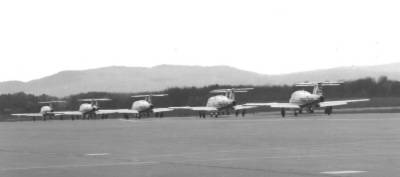I've seen the Snowbirds fly many times, and it's always been an awe-inspiring sight. Eleven years ago, I watched them perform at the now-defunct Plattsburgh Air Force Base in upstate New York. As soon as I heard about today's accident, I immediately thought of this picture that I took on that day.
This is not, after all, the typical Snowbirds shot. The expected picture is one of all nine aircraft in a diamond formation, backdropped against the blue sky. I've taken lots of those, but they don't tell the story inherent in this scene.
I remember thinking as soon as I took it that it was special. The team was taxiing out in advance of its performance. They had just passed the stands, and everyone had already put their cameras down after capturing the typical side-on tarmac pictures. I kept shooting. The forlorn story of planes going off into the unknown struck me as unbelievably poignant.
Sure, the pilots had trained long and hard. They represented the best aviators anywhere in the nation and, arguably, in the world. But out there, anything could happen. And does.
I watched from the ground in London three years ago as two aircraft from the team flew back to the airport here after one of their own had crashed into Lake Erie after clipping another's wing. The pilots ejected and survived that day, but the tenuous thread on which these aviators dance became very real to me that day.
Naysayers will no doubt once again use this tragedy to question why we even bother to do this at all. Calls for disbanding the team have often become more pronounced after a mishap. The U.S. Air Force Thunderbirds and Navy Blue Angels have experienced similar opposition in the past, and likely always will.
That's because some among us don't understand the influential impact of these teams on society. They show us what people can accomplish when they singlemindedly focus on achieving nothing less than the absolute best in themselves. They set the bar high for the rest of us, even if our aspirations never involve aviation. They make us better by setting an example that cannot be ignored.
They also die in the process. But risk is a natural part of this world, and it's something each pilot internalizes before signing up for the job.
I sincerely hope this latest tragedy only serves to reinforce why it is so important to the rest of us that these bastions of excellence continue to be supported by the nations whose flags they so proudly wear.
Earlier this year, I wrote a column on the risks of spaceflight that I'm going to post here later this weekend. In light of this incredibly sad loss, I think it's appropriate to bring the column's message forward at this time.
May the family of the lost pilot, Captain Miles Selby, take comfort in the knowledge that their son, a second-year veteran of the team and an experienced CF-18 Hornet pilot as well, helped countless young people in this country shoot higher than they otherwise would have if they hadn't seen the famous red, white and blue planes fly overhead.





4 comments:
Yeah, this is what I was talking about. Thanks.
"Life is a daring adventure...or nothing at all." -- Helen Keller
"Try everything once with the exception of incest and folk dancing." - Sir Thomas Beecham
Thank you for these quotes! I don't post them nearly as often as I should. I'll try to change that.
Post a Comment